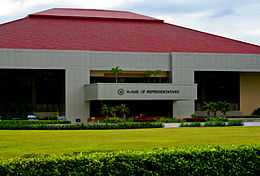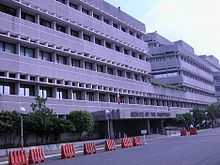Malolos Congress
| Malolos Congress | |
|---|---|
| Philippines | |
 | |
| Type | |
| Type |
Unicameral |
| Houses | La Asamblea De Representantes |
| History | |
| Founded | September 15, 1898 |
| Disbanded | November 13, 1899 |
| Preceded by |
Spanish Cortes Ayuntamiento |
| Succeeded by | Taft Commission |
| Seats | 136[note 1] |
 |
| This article is part of a series on the politics and government of the Philippines |
|
|
Politics portal |
The Malolos Congress or formally known as the "National Assembly" of representatives was the constituent assembly of the First Philippine Republic. It met at the Barasoain Church in Malolos City, Bulacan.[2] It drafted the Malolos Constitution.
The Congress was not much more than a decoration.[2] "That is to show to the foreign correspondents that we Filipinos are civilized, but the bulk of the work in nation building were done at the Malolos Cathedral by the executive branch of government led by (Phiilppine President Emilio) Aguinaldo, who was in command of the army fighting the Americans," said attorney Cris Santiago, past president of the historical society of Bulacan (known as Samahang Pangkasaysayan ng Bulacan or Sampaka).[2]
Political Constitution
Following the declaration of independence from Spain on June 12, 1898 and transformation of the dictatorial government to a revolutionary government on 23 June, the Malolos Congress election was held between June 23 and September 10. On 15 September 1898, the revolutionary congress convened in Barasoain Church in Malolos (now Malolos City, Bulacan) with Pedro Paterno as president and Gregorio S. Araneta as vice president.[3] On 29 September, the 12 June Declaration of independence was ratified.[4] The congress then decided to draft a Constitution, a decision opposed by Apolinario Mabini, the Prime Minister of the revolutionary government (President of the Council of Government).[4] The resulting Malolos Constitution was ratified on November 29, 1898, signed into law on December 23, approved on January 20, 1899, sanctioned by President Emilio Aguinaldo on January 21, and promulgated on January 22.[5][6] The document states that the people have exclusive sovereignty. It states basic civil rights, separated the church from the state, and called for the creation of an Assembly of Representatives (A.K.A. National Assembly) which would act as the legislature. It also calls for a parliamentary republic as the form of government with the president elected for a term of four years by a majority of the Assembly.[7]
Sessions
- Regular Session: September 15, 1898 – November 13, 1899
- Special Session: February 4, 1899
Legislation
Major legislation
| Legislation | Enactment | Ratification |
|---|---|---|
| Declaration of Independence[8] | June 12, 1898 | September 29, 1898 |
| Declaration of War against the United States[9] | June 2, 1899 | June 2, 1899 |
Malolos Constitution
| Malolos Constitution[7] | |
|---|---|
| Approved | Promulgated |
| January 21, 1899 | January 22, 1899 |
Leadership
- President of the Revolutionary Government/First Philippine Republic:
- Prime Minister of the Revolutionary Government/First Philippine Republic (President of the Council of Government):
- Apolinario M. Mabini
- Pedro A. Paterno elected on May 7, 1899
- President of the National Assembly (of Representatives):
- Atty. Pedro A. Paterno - Pedro A. Paterno of Santa Cruz, Manila
- Vice President of the National Assembly (of Representatives):
- Secretaries of the National Assembly (of Representatives):
- Atty. Pablo Roque Tecson - Pablo Roque Tecson: Atty. Pablo R. Tecson of Balanga, Bataan and Atty. Pablo de Leon Ocampo: Pablo Ocampo of Quiapo, Manila.
Council of Government (Cabinet) Members
- Secretary of Finance:
- Mariano Trías y Closas
- Hugo Ilagan elected on May 7, 1899
- Secretary of the Interior:
- Teodoro Sandico
- Severino de las Alas elected on May 7, 1899
- Secretary of War:
- Baldomero Aguinaldo y Baloy
- Mariano Trías y Closas elected on May 7, 1899
- Secretary of Welfare:
- Gracio Gonzaga
- Secretary of Foreign Affairs:
- Apolinario Mabini y Maranan
- Leon Ma. Guerrero - Leon Maria Guerrero elected on May 7, 1899
- Secretary of Public Instruction:
- Aguedo Velarde
- Secretary of Public Works and Communication:
- Maximo Paterno
- Secretary of Public Works and Communication:
- Leon Ma. Guerrero - Leon Maria Guerrero
- Representatives: Pablo Tecson: Brigadaire General Pablo Ocampo Tecson of San Miguel, Bulacan, who is a family to: Atty. Pablo Roque Tecson of Balanga, Bataan. And other Filipino Revolutionist.
Members (Representatives)

Among the 85 delegates who convened in Malolos, there were 43 lawyers, 17 doctors, five pharmacists, three educators, seven businessmen, four painters, three military men, a priest and four farmers.[2] Five of the 85 delegates did not have a college degree. [2]
_and_ten_of_the_delegates_to_the_first_Assembly_of_Representatives_that_passed_the_Con_-_NARA_-_530993.tif.jpg)
List of National Assembly Representatives (members) by province as of July 7, 1899.[10][11]
| Province | Elected | Appointed |
|---|---|---|
| Manila | 4 | 0 |
| Batangas | 4 | 0 |
| Bulacan | 4 | 0 |
| Cavite | 4 | 0 |
| Camarines | 4 | 0 |
| Ilocos Sur | 3 | 1 |
| Ilocos Norte | 6 | 0 |
| Laguna | 4 | 0 |
| Pampanga | 4 | 0 |
| Pangasinan | 2 | 2 |
| Iloilo | 0 | 4 |
| Cebu | 0 | 4 |
| Leyte | 0 | 4 |
| Albay | 4 | 1 |
| Cagayan | 1 | 2 |
| Bataan | 3 | 0 |
| Isabela | 2 | 1 |
| Union | 1 | 2 |
| Nueva Ecija | 3 | 0 |
| Tarlac | 3 | 0 |
| Zambales | 2 | 1 |
| Sorsogon | 0 | 3 |
| Negros Occidental | 0 | 3 |
| Negros Oriental | 0 | 3 |
| Samar | 0 | 3 |
| Capiz | 0 | 3 |
| Antigua | 0 | 3 |
| Bohol | 0 | 3 |
| Zamboanga | 0 | 3 |
| Misamis | 0 | 3 |
| Calamianes | 0 | 3 |
| Masbate | 0 | 3 |
| Mindoro | 1 | 2 |
| Morong | 2 | 0 |
| Lepanto | 3 | 0 |
| Batanes Islands | 1 | 1 |
| Nueva Vizcaya | 1 | 1 |
| Abra | 1 | 0 |
| Padre Burgos (Benguet) | 1 | 2 |
| Catanduanes | 0 | 2 |
| Paragua | 0 | 2 |
| Totals | 68 | 68 |
| 136[note 1] | ||
See also
Notes
- ↑ 1.0 1.1 Filipino historian Teodoro Agoncillo, in his book Malolos, numbered the delegates as of July 7, 1899 at 193 (42 elected and 151 appointed).[1]
References
- ↑ Teodoro A. Agoncillo (1897), Malolos: The Crisis of the Republic, University of the Philippines Press, pp. 224 and Appendix F (pp,658–663), ISBN 978-971-542-096-9
- ↑ 2.0 2.1 2.2 2.3 2.4 Balabo, Dino (December 10, 2006). "Historians: Malolos Congress produced best RP Constitution". Philippine Star. Retrieved 12 August 2013.
- ↑ Kalaw 1927, pp. 120, 124–125
- ↑ 4.0 4.1 Kalaw 1927, p. 125.
- ↑ Guevara 2005, p. 104.
- ↑ Tucker, Spencer C. (2009). The encyclopedia of the Spanish-American and Philippine-American wars: a political, social, and military history. ABC-CLIO. pp. 364–365. ISBN 978-1-85109-951-1.
- ↑ 7.0 7.1 Guevara, Sulpico, ed. (2005). The laws of the first Philippine Republic (the laws of Malolos) 1898-1899. Ann Arbor, Michigan: University of Michigan Library (published 1972). pp. 104–119. Retrieved 2008-03-26.. (English translation by Sulpicio Guevara)
- ↑ The Act of Declaration of Philippine Independence
- ↑ "Pedro Paterno's Proclamation of War". MSC Schools, Philippines. June 2, 1899. Retrieved 2007-10-17.
- ↑ Kalaw, Maximo M. (1927). "The development of Philippine politics". Oriental commercial. p. 121. Retrieved 2008-03-22. (citing Volume II, Galley 2 of Major J. R. M. Taylor's translation and compilation of captured insurgent records (Taylor 1907))
- ↑
- War Department, Bureau of Insular Affairs (1907). "I. Telegraphic Correspondence of Emilio Aguinaldo, July 15, 1898 to February 28, 1899, Annotated". In Taylor, John R.M. Compilation of Philippine Insurgent Records (archived from the original on 2008-10-03). Combined Arms Research Library. Retrieved 2008-03-10.
External links
- "History of the Senate". Senate of the Philippines. Retrieved 2007-04-01.
- "The LAWPHiL Project - Philippine Laws and Jurispudance Databank". Arellano Law Foundation. Retrieved 2006-09-16.
Further reading
- Philippine House of Representatives Congressional Library
- Corazon L. Paras. (2000). The Presidents of the Senate of the Republic of the Philippines. Quezon City: Giraffe Books. ISBN 971-8832-24-6.
- Pobre, Cesar P. (2000). Philippine Legislature 100 Years. Quezon City, Philippines: New Day Publ. ISBN 971-92245-0-9.
| ||||||||||
| ||||||||||||||||||||||||||||



